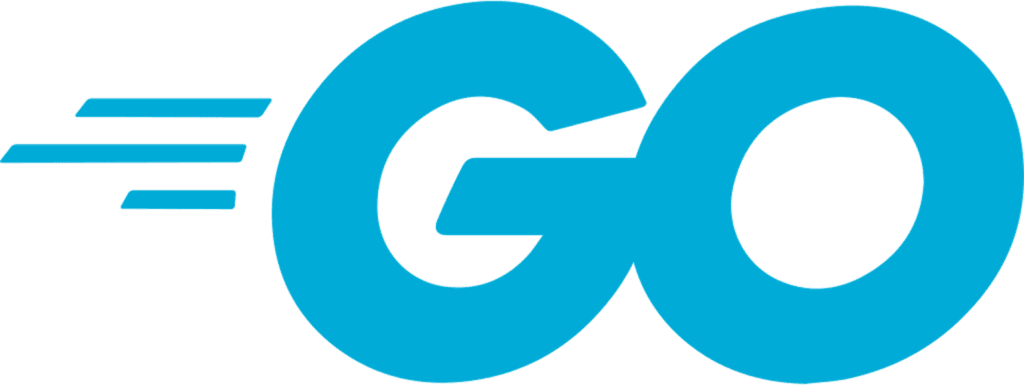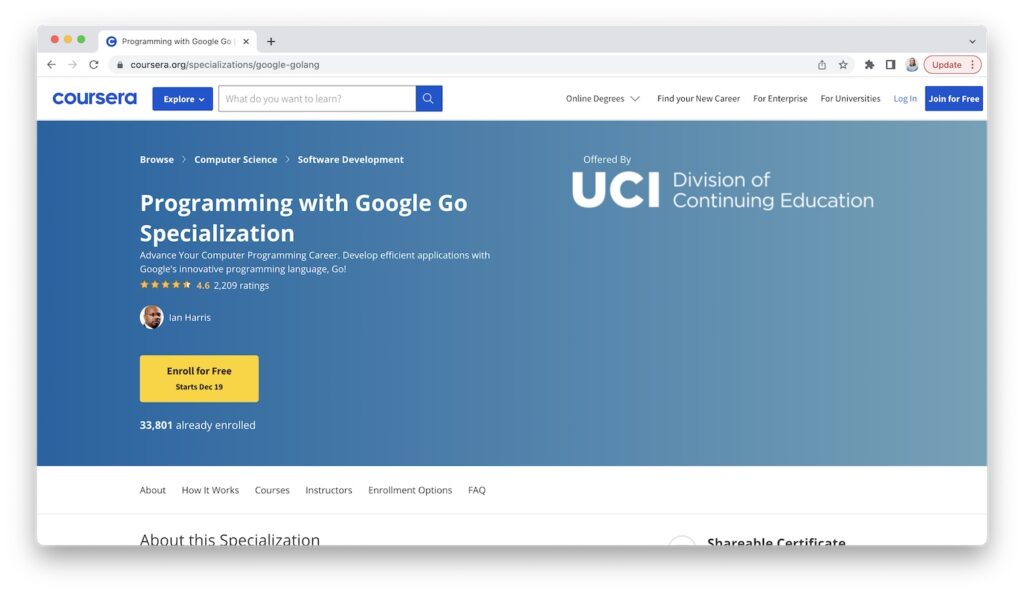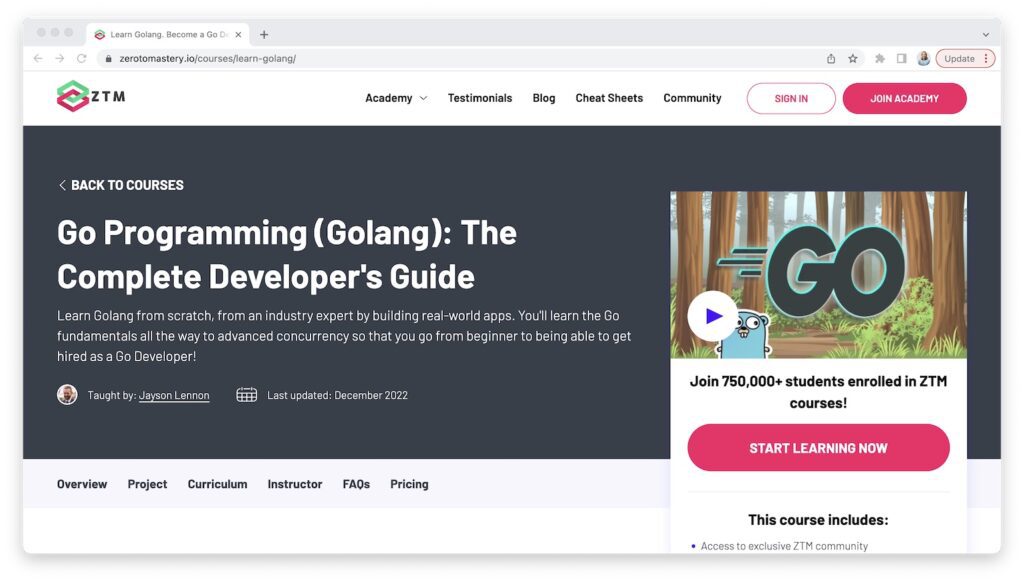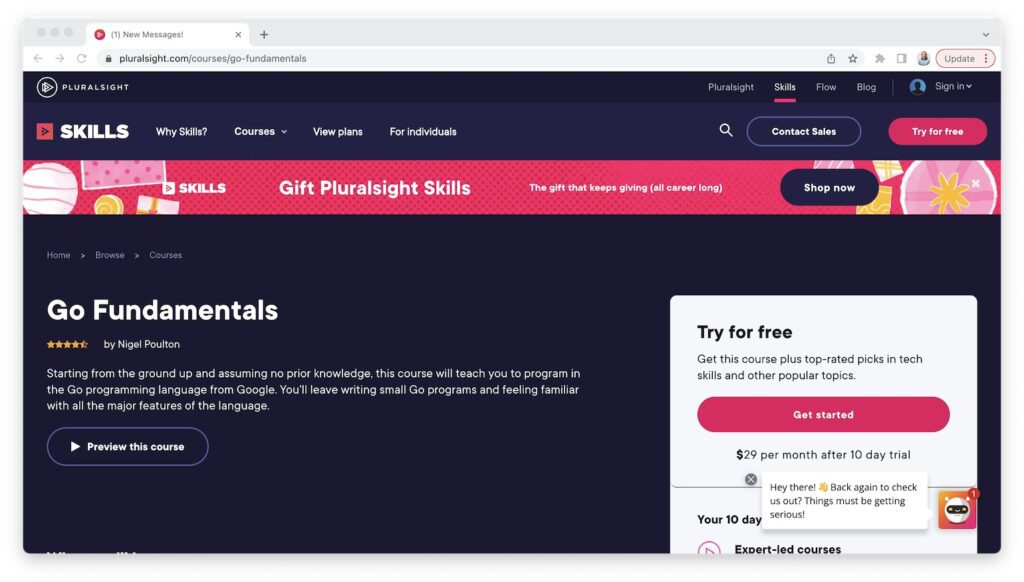Go, sometimes referred to as Golang, is a statically typed, compiled programming language designed at Google in 2007.
It makes it easy to build simple, reliable, and efficient systems, and is modeled after C. You may have seen its mascot before: the Go gopher.
According to Hired’s 2022 State of Software Engineers report, Go programming has been the #1 most in-demand software engineering skill for two years in a row.
In this post, we’ll cover what Go is, Go vs. Golang, a little about how the Go computer language works, what it’s used for, the benefits of coding with Go, and where to learn Go language skills.

Disclosure: I’m a proud affiliate for some of the resources mentioned in this article. If you buy a product through my links on this page, I may get a small commission for referring you. Thanks!
What Is Go Language?
What is Golang/Go language? Go is a statically typed, compiled programming language that feels like a dynamically typed, interpreted language.

It is also fast. According to Go’s website, “it should take at most a few seconds to build a large executable on a single computer.”
Due to its “concurrent” nature, it can run multiple tasks at the same time, independently of each other. Go has rich support for this, which makes it unique.
☝️ Back to top
Go or Golang?
If you’ve heard of the Go coding language, you may have also heard it called Golang. So which is right: Go vs Golang?
The proper/official name for Go is “Go.” The reason you might see “Golang” is because of its former domain name, golang.org—an abbreviation of “Go language.”
People do still refer to it as both Go and Golang. It can be especially helpful on Twitter, for example, where the tag #go would be too generic so people use #golang.
Start coding now
Stop waiting and start learning! Get my 10 tips on teaching yourself how to code.
Why Go Was Created: A Brief History
Go was designed at Google by Robert Griesemer, Rob Pike, and Ken Thompson in 2007. It was created to improve programming productivity and make the development process less complex.
They wanted to fix problems and criticisms of the other languages that were used at Google to build servers and distributed systems, but keep all the good stuff about them. It was mainly built to improve C++ (which all three of Go’s creators hated).
Go was publicly announced in November 2009, and version 1.0 was released in March 2012. It is now on version 1.19.
What Is Golang Used For?
So, what is Go programming language used for today? Some of its main applications include:
- ☁️ Building cloud & network services (it has a strong ecosystem of tools and APIs to help with this)
- 👨💻 Building command-line interfaces
- 💻 Web development
- 📈 DevOps & site reliability
You can also see how real companies are using Go here. For example, Microsoft uses Go to power pieces of its cloud infrastructure. Uber uses Go to power its real-time data analytics dashboards.
☝️ Back to top
Why Learn Go?
Thinking about what programming language to learn next? Here are a few compelling reasons to learn Go language:
- 🧠 It’s easy to learn: The documentation is easy to read and it has an easy-to-understand syntax
- 💨 It’s fast: Since Go is a compiled language, it is directly translated to machine code before execution (unlike interpreted languages)
- 🤝 Lots of support/strong community: You can build Go applications on Windows, Linux, and Mac. There are tons of integrated development environments (IDEs) that support Go. There are 191K people subscribed to the Go subreddit, just to give you an indication of the size of the community out there.
- 💰 It pays well: Go developer salaries range from $80k/year to $164K+ per year
- 📈 It’s in demand with employers: According to Hired, the most in-demand software engineering skill in 2021 was Go. “Go-skilled” engineers received 1.8x more interview requests compared to the marketplace average
- ❤️ People enjoy using it: According to the Go Developer Survey 2022, satisfaction with Go is high: 93% of respondents said they were “somewhat” (30%) or “very” (63%) satisfied
As you can see, there are a ton of good reasons to add the Go programming language to your skills arsenal!
☝️ Back to top
Where to Learn Go: 5 Intro to Golang Courses
The five courses below are great options to learn Go!
Whether you just want a quick Golang intro to get a feel for the language, or a complete guide that gets you ready to develop with Go, one of these should suit your needs.
1. Programming with Google Go Specialization on Coursera

A good intro to the Go programming language, this specialization includes 3 courses in total. You’ll have an opportunity to create your own Go applications so you can practice what you’re learning. You’ll also learn Go’s capabilities for concurrent programming by developing several example programs.
2. Learn Go on Codecademy

This Golang intro course covers how to set up a Go environment and how to create a Go file. Plus, learn about Go’s data types and variables, Go’s conditional statements, and using functions in Go. You’ll build 4 different projects in this course.
3. Go: The Complete Developer’s Guide (Golang) on Udemy

This Go course will help you understand the basic syntax and control structures of the Go language, including how to apply Go’s concurrency model, organize code through the use of packages, use the Go runtime to build and compile projects, and more.
4. Go Programming (Golang): The Complete Developer’s Guide on Zero to Mastery

Start by learning Go fundamentals and continue all the way to advanced concurrency. As a final project, you’ll create an enterprise-level Pixl Art editor with Go.
5. Go Fundamentals on Pluralsight

Perfect for complete beginners, as it assumes you have no prior Go knowledge. By the end of this Golang intro course, you’ll know how to write small Go programs and be familiar with all the major features of the language.
Not ready to commit to a paid Go course? No problem. Check out these free Go resources, including a Golang playground you can experiment with.
☝️ Back to top
Start coding now
Stop waiting and start learning! Get my 10 tips on teaching yourself how to code.
Time to Learn Go?
If you’re pursuing a career like software engineering, learning Go can be a great option. It’s in demand, easy to learn, well-liked by developers, and used by a ton of companies.
It also has a lot of different applications, so it can make you more qualified for a lot of lucrative roles in tech. That’s why there are currently over 7,000 open Go jobs on Indeed, and the average salary for a Go developer is $102,419 per year!
➡️ Try out a few free Go resources or consider taking a course, and see where it takes you.
Get ready, set, and Go! 🤪

